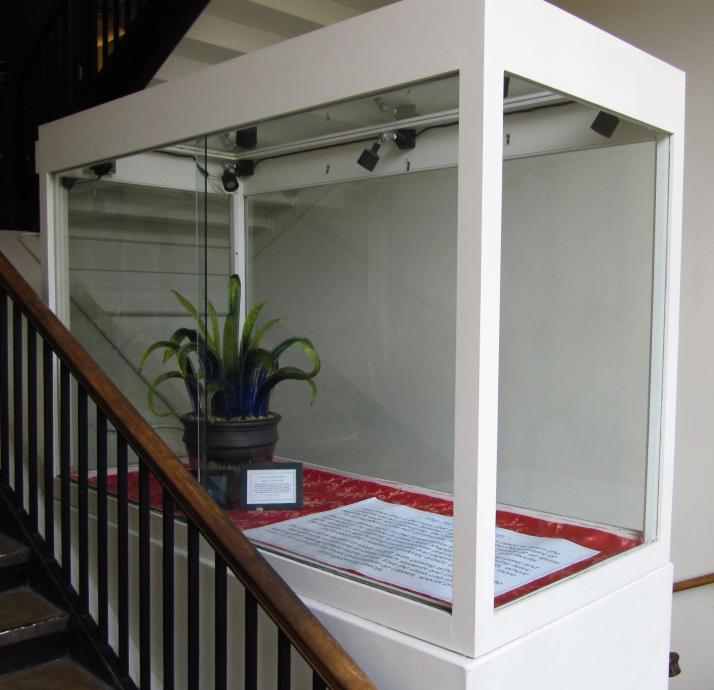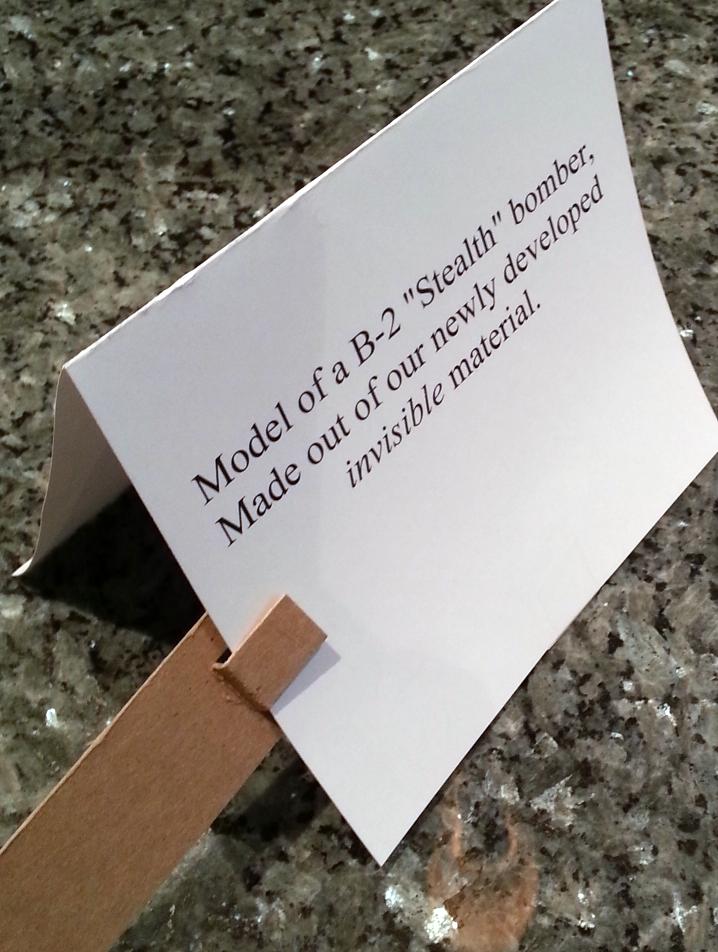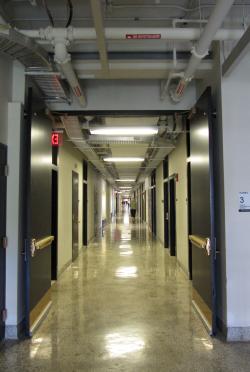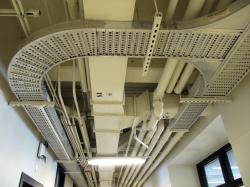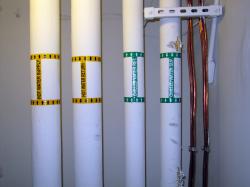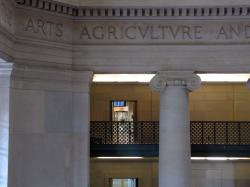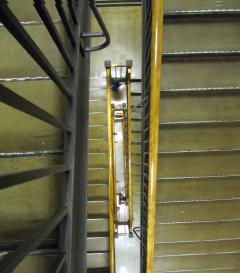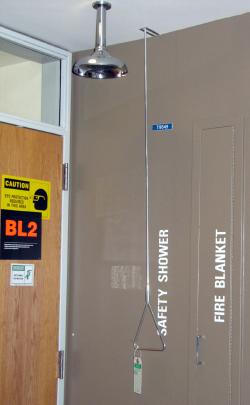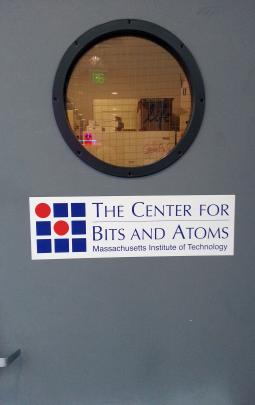 I studied at the Massachusetts Institute of Technology ("MIT") for over a decade, first as an undergraduate, and then as a graduate student. In a previous blog entry, I described some of the MIT people I had contact with while a student. After receiving my Ph.D. in 1970, I went on to a 33-year career in electrical engineering and computer science. Shortly after I retired in 2003, I started working as a volunteer mentor for MIT's Venture Mentoring Service. As a result, I find myself at MIT several times a month. I find many interesting things to see just walking around the campus. The photos in this entry are recent; they are not images from when I was a student in the Sixties. Note 1
A number of years ago, I noticed that this display case was not as shown, but rather was empty, and it remained so as I passed it on quite a few subsequent visits. And this display is in a prime location, since it's at one end of what one might call MIT's main corridor, and an enormous number of people pass it every day. A plaque identified the case as belonging to the Department of Materials Science and Engineering. This made me think of a way to comment on its emptiness. There's a longstanding tradition of "hacks" at MIT - practical jokes and pranks. Note 2 So I decided to comment in an amusing way, by putting a sign into the case. The sliding glass doors to the case were locked, but I didn't see that as a major obstacle. Back at home, I created the sign I wanted. I don't remember the exact wording I used, but because the display case belonged to the Department of Materials Science and Engineering, I wrote something like this:
In addition to the sign, I made a tool out of a piece of light-weight cardboard, with a shape cut into its end that would allow me to push on the edge of the sign, also as shown. On a subsequent visit to MIT, I waited until nobody was around. I then folded the sign flat, and used my improvised cardboard tool to push it into the case, through the narrow gap between the two sliding glass doors. Success! Once inside, the sign sprung open, and remained standing as I pulled the cardboard pusher back out through the gap. From time to time, I checked to see if the sign was still there (although not all my trips to MIT took me to that side of the campus). It remained for a while, but eventually someone removed it. Nevertheless, I think my message was received, because not long thereafter, the Department of Materials Science and Engineering put some sort of exhibit into the case, and there's been something in it ever since (the first picture in this entry shows an exhibit that was in place in October, 2010). My action wasn't much as far as MIT "hacks" go, but it had an objective, and it seemed to be effective. Also in accord with the MIT hacking ethic, I hope it was perceived as humorous, and it caused no damage or injury. May, 2014 note: I submitted the above story to the MIT student newspaper, The Tech, and they printed it in the paper in the "Campus Life" column. Click here to see the on-line version. I find just walking around MIT to be fascinating. Here are some rather randomly chosen scenes: A word on the safety shower seen above. These are located near any laboratory that makes use of potentially dangerous chemicals, particularly acids. Users of these facilities are instructed to note and remember their locations. A person who is splashed with a corrosive chemical, such as an acid, can run under one of these shower heads, and pull the handle. He or she will then be doused with water to dilute the dangerous chemical, a treatment which is particularly effective with acids. When I was an undergraduate, I heard of a curious student who wanted to see one of these showers in action. He put a wastebasket under the shower head, and pulled the handle. He only pulled it briefly, and then released it, thinking it would only run for a little while, and the water would be caught by the wastebasket. He was mistaken. These showers have a large tank overhead in the ceiling, and once the handle is pulled, the water runs until the tank has been emptied (it's sort of like flushing a toilet). Furthermore, the water comes in a torrent. The wastebasket was filled in a second, after which many additional liters of water flooded the hallway. By the way, "curious student" is redundant at MIT. All MIT students are curious. I took a picture of the door labeled "The Center for Bits and Atoms" because it seemed to me to be such a typical MIT name, the sort of thing you won't find in very many other places. MIT displays a lot of art, by the way - statues, paintings, photographs, mobiles, stabiles, and other installations. These are not the focus of this entry. My signature for this entry can be seen in a sign located in front of the Stata Center (building 32) on Vassar Street: 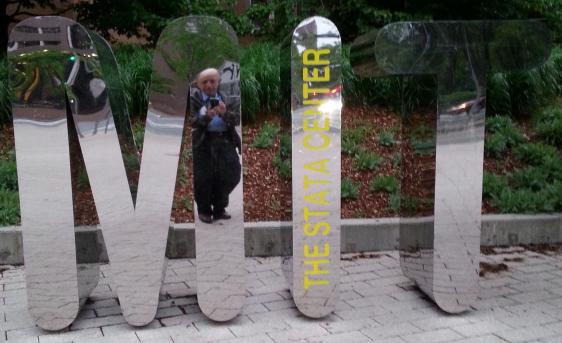 I'm sure you can spot my image on the right-side of the M of MIT - a sort of fun-house reflection of me taking the picture with my cellphone camera (you can click on the picture to enlarge it if you want to see me better). I have many more photos of interesting things seen at MIT, but I've already included too many for one blog entry. I love just walking around the place - I never know what I may come across.
  Note 1: Parking on or near the MIT campus is tough, and they actually make me pay for a volunteer parking pass. The price rises each year. This year it cost me an annual fee of $309 for occasional parking in the West Garage, only to attend Venture Mentoring Service meetings. [return to text] Note 2: You can find all sorts of material on hacks at MIT. The Wikipedia article provides a good summary. There's a webpage on the subject called the IHTFP Gallery. There's a book called "Nightwork: A History of Hacks and Pranks at MIT", and another called "The Journal of the Institute for Hacks, Tomfoolery & Pranks at MIT". You may notice that that the initial letters of the title words of the latter (including the "F" of TomFoolery) spell out the same IHTFP as the name of the web page. This is an acronym that is believed to have originated in the 1950's at MIT. It means, "I Hate This Fucking Place". It was certainly much used in the early sixties when I was a student. According to the Urban Dictionary page on the subject, it was "Adopted by attendees of numerous schools afterwards; most notably by the three US service academies, where the letters find their way into not only conversation, but a great deal of graffiti-like uses and spirit missions, or both. Most cadets/midshipmen tend to believe their school (West Point, Annapolis, or USAFA) was the one to originate the term." [return to text]
 |
